What is an optical device. Presentation on the topic "optical devices"
different kind optical instruments allowed people to make many different discoveries. With their help, people discovered the existence of microorganisms and discovered most of the celestial bodies known to us today. Not to mention that millions of people use optical devices every day..
background
One of the first optical instrument used great physicist ancient times Archimedes. Probably everyone knows the history of the heroic defense of Syracuse, but it would not be amiss to repeat one of its episodes. With the help of glass and sunlight, Archimedes caused a fire that destroyed the Roman fleet. Can this episode be considered the starting point in the history of the use of optical instruments? Probably yes, but still not entirely. In the end, the brilliant experiments of Archimedes did not become widespread. Mankind realized only much later what a gigantic benefit optics can bring to it. In the XIII-XIV centuries. ekah in Europe began to massively used glasses. They were put on, however, only for reading. They were also used in Russia. So, Tsar Alexei Mikhailovich always wore reading glasses. That's just the temples for glasses appeared only in the XVIII century.
One of the first optical devices used by Archimedes
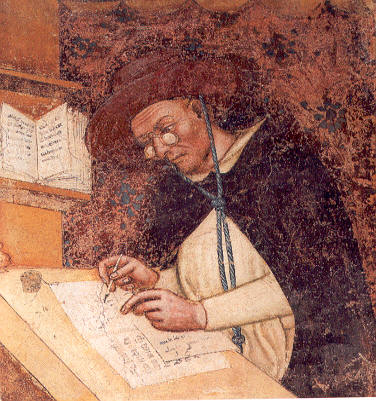
The success of eyeglasses led many scientists to the idea that optical instruments could be used in other ways. In 15th-century France, an inventor named Jacques Progenel was trying to create some sort of solar cannon. It was based on the principle of Archimedes. Sunshine, with the help of several magnifying glasses, was supposed to give a flame, which, in turn, could start a fire. It is not known what Progenel's experiments led to, but the solar gun was never adopted by either France or any other country.
Microscopes and telescopes
Microscopes and telescopes should, of course, be considered the first optical instruments. At the time of their creation, Europe had already experienced a kind of optical boom. At the turn of the 16th-17th centuries, many master glaziers and scientists experimented with glass. Among them were Dutch spectacle makers Hans Jansen and his son Zachary Jansen. It was they who created the first microscope in history. It was in 1590. True, it was not they who achieved the greatest success in the manufacture of these devices, but Galileo Galilei. The great Italian created several types of microscopes, and he gave some of them as gifts. strong of the world this. He received such a gift from him, in particular, polish king Sigismund III. And already in the 18th century, Peter the Great had his own microscope. The future Emperor saw him in Holland during his famous journey as part of the Grand Embassy. Peter liked the microscope so much that he literally demanded that it be presented to him. By the time Peter got acquainted with microscopes, the technique for making these instruments had made some progress. In 1674, the Dutchman Anthony van Leeuwenhoek improved microscopes, which made it possible to enlarge the image by 250-270 times.
Galileo created several types of microscopes
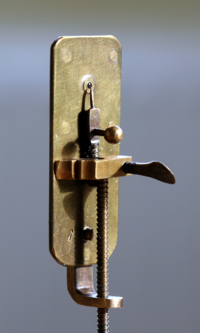
Telescopes began to appear around the same time. In 1609, the Dutchman Johann Liepersgey presented in The Hague his “tube for studying the luminaries”. But the patent was not issued to Lipersgey on the basis that something similar had already been created at the Jansen enterprise. Galileo continued his experiments in those days.
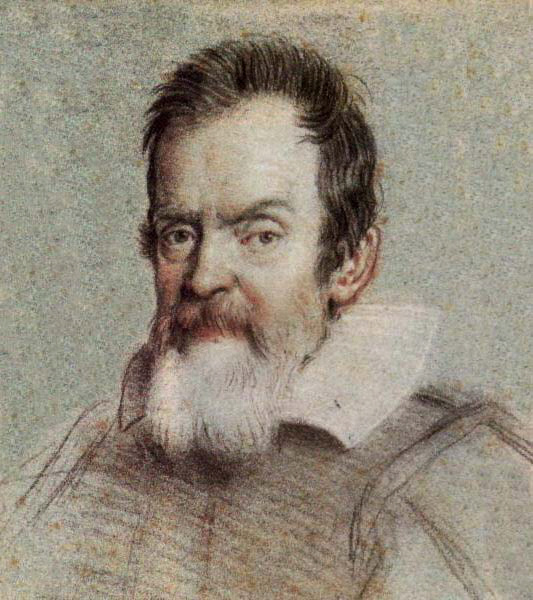
It was he who first pointed the telescope into the sky. Later, with the help of this device, people will discover Uranus, Neptune, as well as others. solar systems and galaxies.
In Russia
Optical instruments reached Russia with some delay. They appeared mainly in the homes of wealthy nobles and mainly for fun. It is not known how Peter the Great used his microscope. He looked into it or just kept it somewhere. And yet, these devices were well known in Russia. Moreover, many of our cities were often visited by foreign entrepreneurs who started trading in optics. So in the middle of the 19th century, the Swiss Theodor Schwabe arrived in Moscow from Berlin (in Russia he was called Fyodor Borisovich Schwabe). In 1837, he opened a shop selling glasses, pince-nez and other small optical instruments on Kuznetsky Most. But Schwabe had almost no competitors, optics was new for Russia, and the business of the enterprising Swiss quickly went uphill. The shop turned into a firm, and the firm into a company. "Shvabe" was engaged in the repair, as well as the manufacture of very large optical instruments, including periscopes and telescopes. In the early 50s, Nicholas I turned his attention to the company.
In the 18th century, Peter the Great had his own microscope
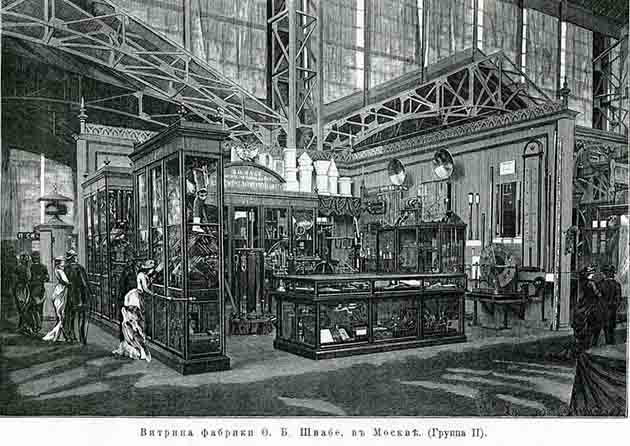
Soon Shvabe became a supplier of the imperial court and almost a monopolist in the production of all kinds of optics. Now Shvabe is a holding company, which is part of the state corporation Rostec.
Current state
The demand for optical instruments continues to grow. There are now 19 research and production associations operating under the Shvabe brand. Here, Rostec produces more than 6,000 thousand various types optical devices. Three quarters of these products are military purpose. Modern optoelectronic equipment is supplied to aviation, the navy and even to the space forces.
Now optoelectronic equipment is even supplied to the space forces
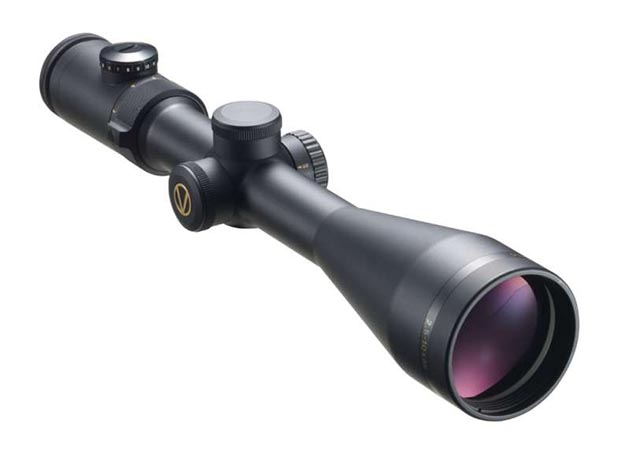
Yes, on spaceships the devices for remote sensing of planetary surfaces created by Rostec are being installed. In addition, the Shvabe holding supplies equipment for medical and scientific purposes. Binoculars and optical sights are also produced here.
Presentation on the topic "Optical devices"
And what is it, optical devices?
Optical devices are devices in which the radiation of any region of the spectrum (ultraviolet, visible, infrared) is converted for normal perception by the human eye.
Optical devices that arm the eye Devices for viewing small objects (loupes and microscopes) Devices for viewing distant objects (spotting scopes, telescopes, binoculars, etc.) Angular magnification - the ratio of the angle of view when observing an object through an optical device to the angle of view when observed by the naked eye (characteristic of an optical device)
Lens from German Linse from Latin lens lentil
This is a part of an optically transparent homogeneous material, limited by two polished refractive surfaces of revolution, for example, spherical or flat and spherical.
The eye as an optical instrument The eye is optical system, giving a reduced, inverse, actual image on a light-sensitive mesh shell eyeball. The main element of the optical system of the eye, the lens is biconvex lens. The curvature of the surface of the lens can change, so it is always possible to bring the image of an object to the surface of the retina. This process is called accommodation of the eye. Aqueous moisture of the anterior chamber, lens and vitreous body represent a single optical system of the eye
What this eye does not look at - All the pictures will convey
Camera (photographic apparatus, camera) - a device (device, mechanism, design) for obtaining and fixing still images of material objects using light.
Telescope (from Dr. Greekτῆλε [tele] - far + σκο πέω - I look) - an instrument that helps in observing distant objects by collecting electromagnetic radiation (for example, visible light). Photo taken with a telescope
Loupe - a converging lens or short focal length lens system A magnifying glass is placed close to the eye and an object is placed at its focal length. plane- angle, under which the object is visible through a magnifying glass. F - focal length of the magnifier. - angular magnification of the magnifier. The magnification given by a magnifying glass is limited by its size. Magnifiers are used by watchmakers, geologists, botanists, numismatists
A magnifying glass is the angle of view at which an object can be seen with the naked eye. d0=25cm - distance best vision. h is the linear size of the object.
The magnifying glass is placed close to the eye, and the object is placed in its focal plane - the angle at which the object is visible through the magnifying glass. F is the focal length of the magnifier. - angular magnification magnifier
Microscope Microscope opened to man new world, far pushing the boundaries of our natural vision. No less than a heavy whale in the abyss A small worm of parts crushes us If the microscope reveals many secrets to us Invisible particles and thin veins in the body! wrote M.V. Lomonosov in “Letter on the benefits of glass”
This is the end of the presentation, I hope you enjoyed it
Cameras. Camera. Optical devices. My physics instrument. The eye as an optical instrument. Magnifier device. Optical devices in medicine. Topic: "Optical device-eye". The eye as an optical instrument and vision. The history of the development of the camera. Department "Electronic devices and devices". Lesson topic: "Electric lighting devices."
Classification and designation of semiconductor devices. A compass is a device that helps to determine the cardinal directions. Stopsleep is a device for drivers and not only. The most amazing optical device. Physical phenomena in optical devices. CRAB (device for integrated assessment performance of athletes).
Examples of a new product. A samovar is a physical device. Inventors of the 18th century in Russia. Household appliances for personal hygiene. Optical instruments in physics grade 11. Instruments And Methods For Radiometric Measurements. The need to create counting instruments V.Ya.Bunyakovsky.
Presentation on the topic: Optical devices
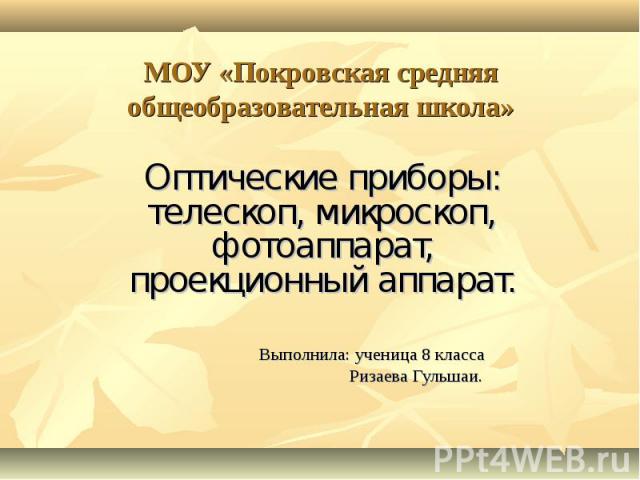
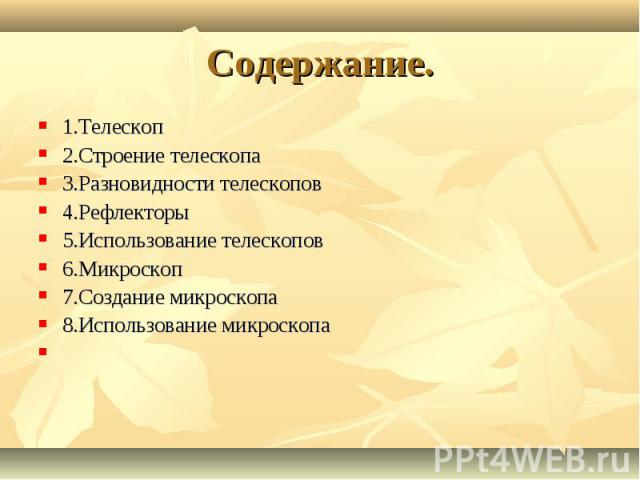
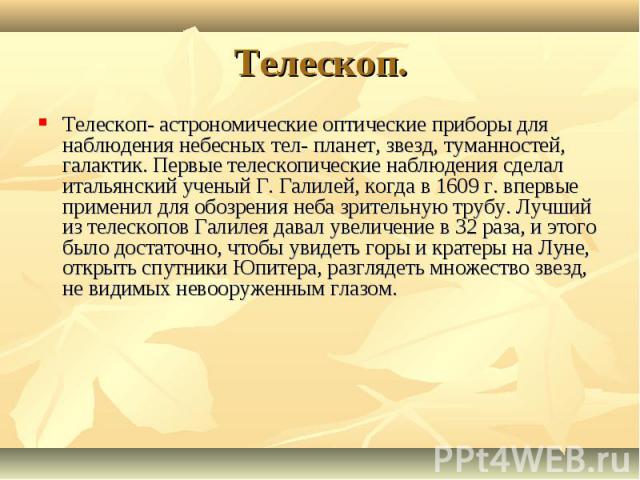
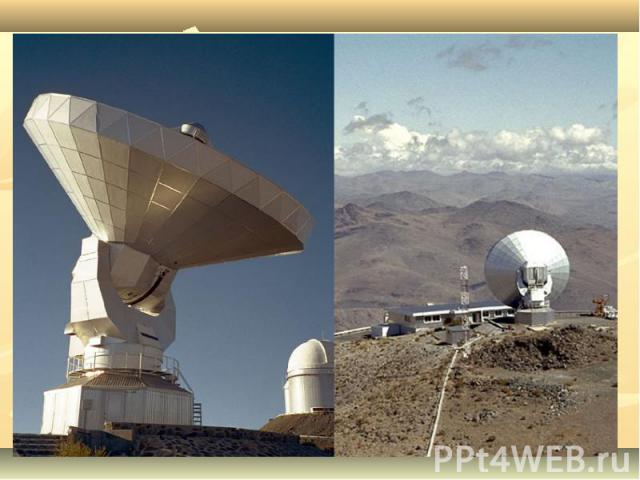
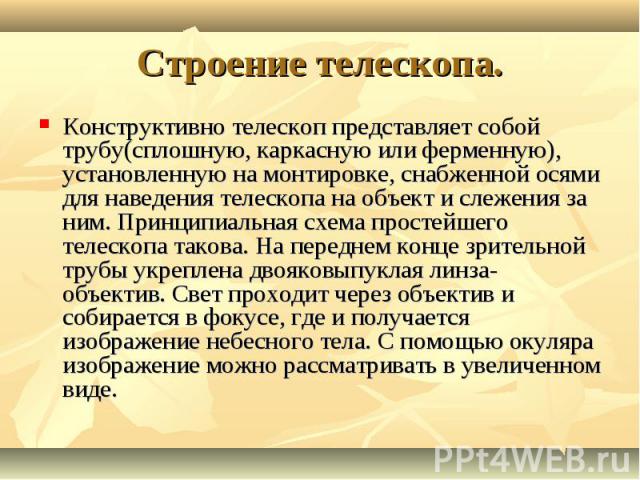

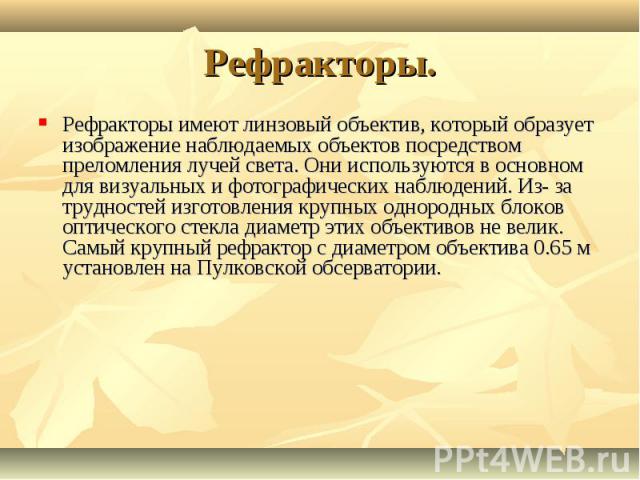
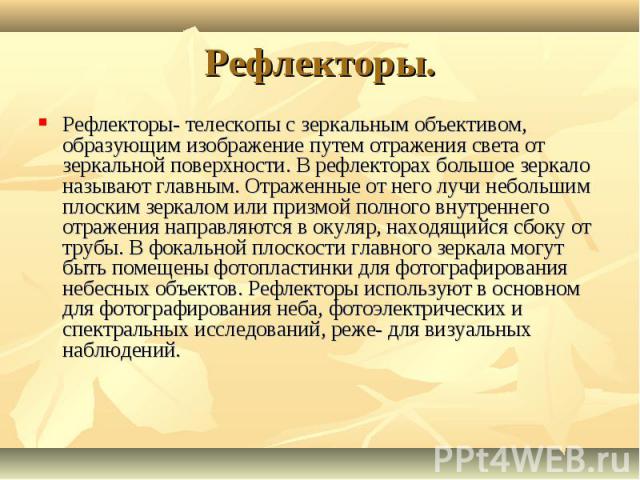
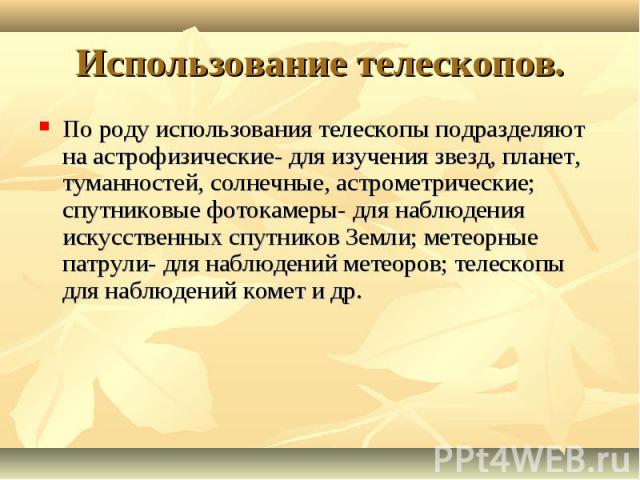

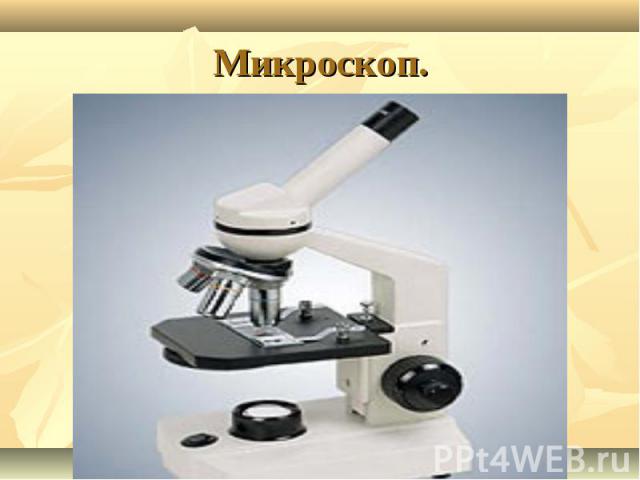
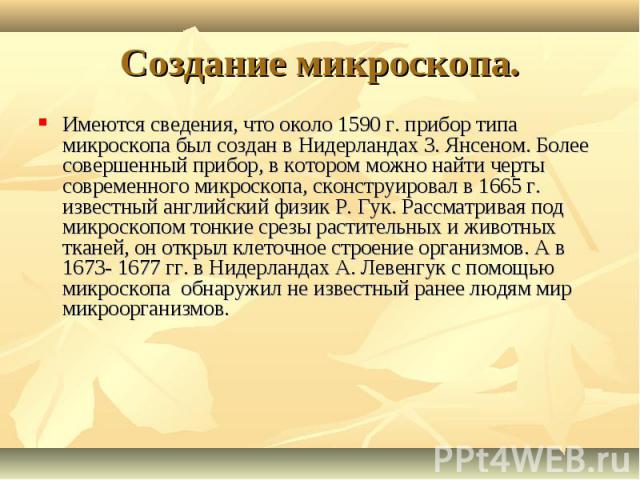

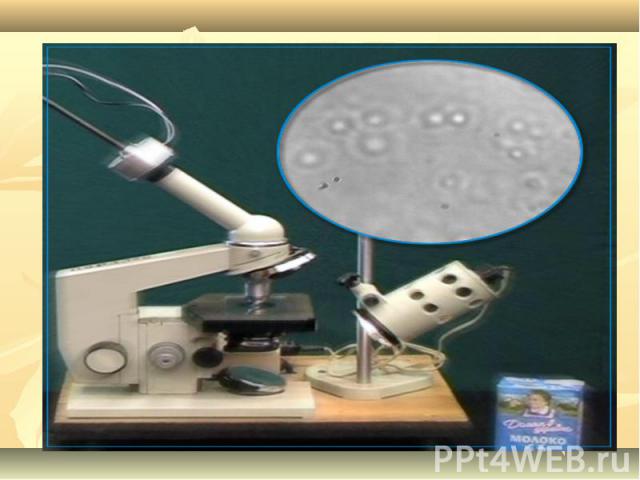
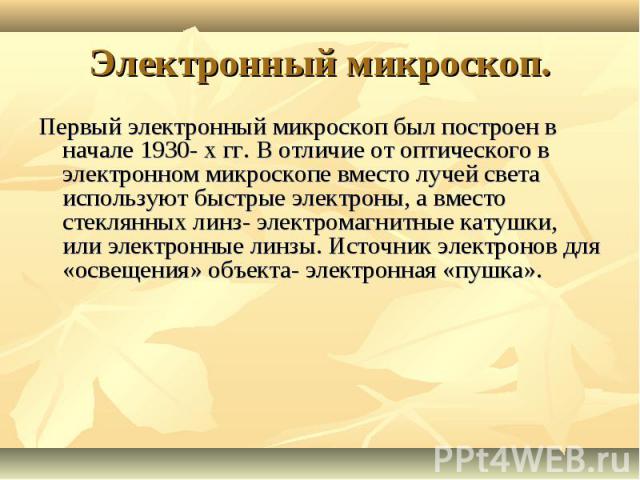

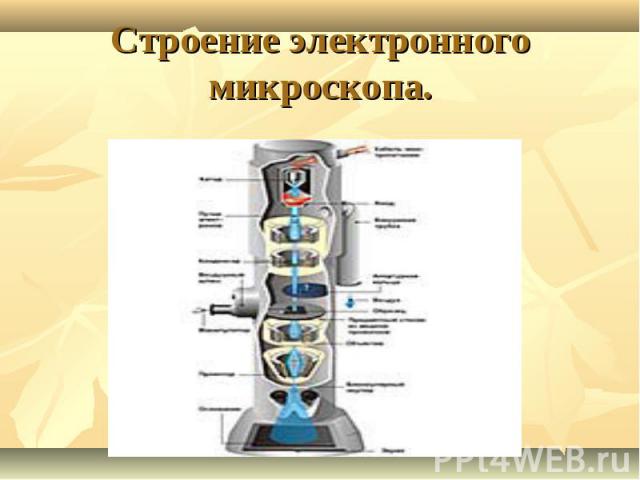

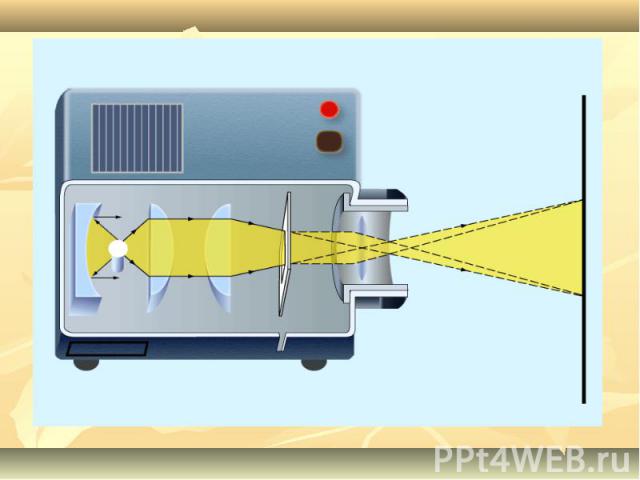
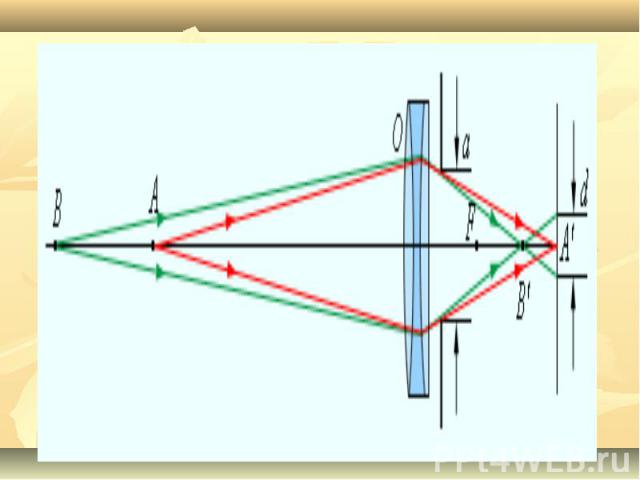
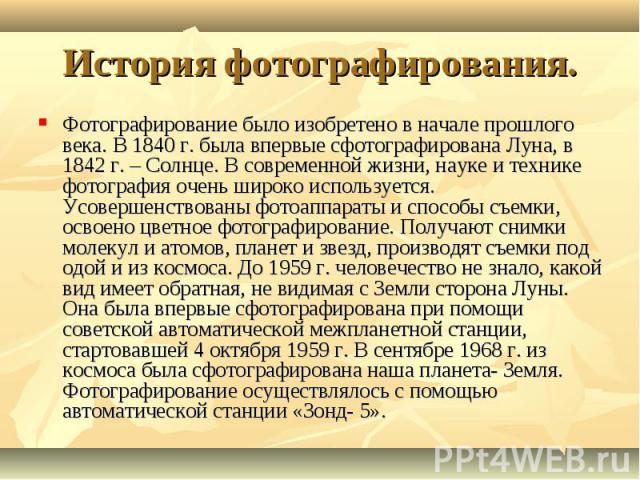
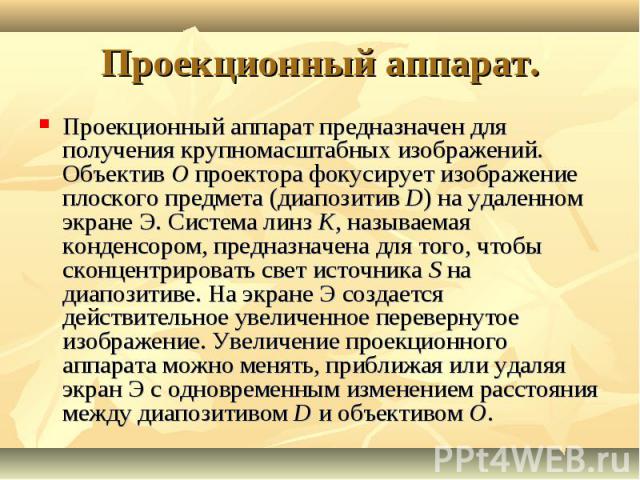
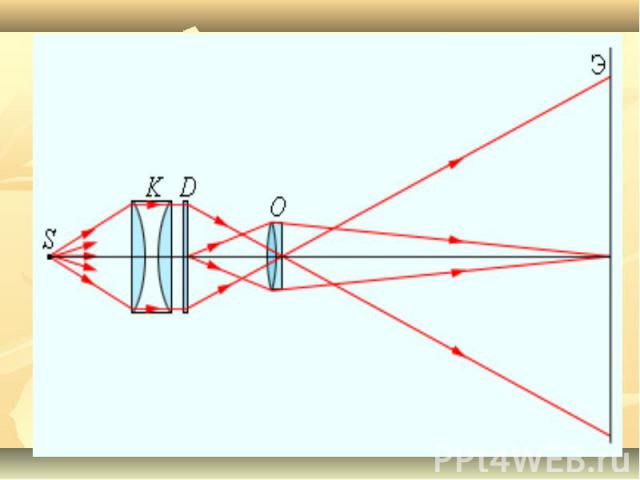
1 of 23
Presentation on the topic: Optical devices
slide number 1
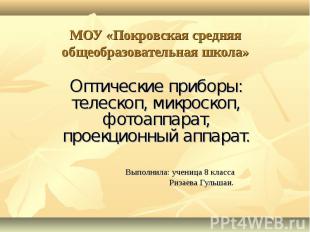
Description of the slide:
slide number 2
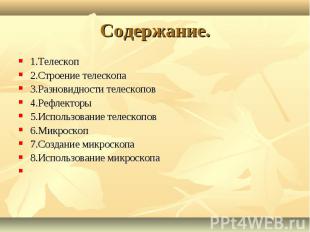
Description of the slide:
slide number 3
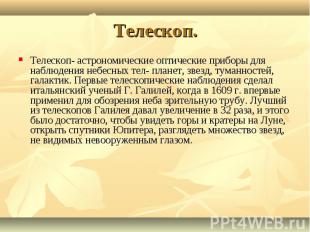
Description of the slide:
Telescope - astronomical optical instruments for observing celestial bodies - planets, stars, nebulae, galaxies. The first telescopic observations were made by the Italian scientist G. Galilei, when in 1609 he first used a telescope to view the sky. The best of Galileo's telescopes gave a magnification of 32 times, and this was enough to see the mountains and craters on the moon, discover the satellites of Jupiter, and see many stars that are not visible to the naked eye. Telescope - astronomical optical instruments for observing celestial bodies - planets, stars, nebulae, galaxies. The first telescopic observations were made by the Italian scientist G. Galilei, when in 1609 he first used a telescope to view the sky. The best of Galileo's telescopes gave a magnification of 32 times, and this was enough to see the mountains and craters on the moon, discover the satellites of Jupiter, and see many stars that are not visible to the naked eye.
slide number 4
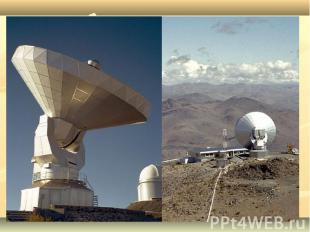
Description of the slide:
slide number 5
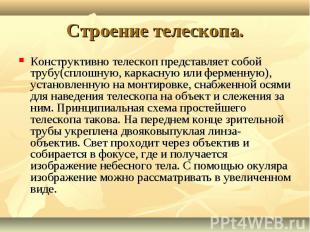
Description of the slide:
Structurally, a telescope is a tube (solid, frame or truss) mounted on a mount equipped with axes for pointing the telescope at an object and tracking it. The schematic diagram of the simplest telescope is as follows. At the front end spotting scope reinforced biconvex lens-objective. Light passes through the lens and is collected at a focus, where the image is formed. celestial body. With the help of an eyepiece, the image can be viewed in an enlarged form. Structurally, a telescope is a tube (solid, frame or truss) mounted on a mount equipped with axes for pointing the telescope at an object and tracking it. The schematic diagram of the simplest telescope is as follows. A biconvex lens-objective is fixed at the front end of the telescope. Light passes through the lens and is collected at a focus, where the image of a celestial body is obtained. With the help of an eyepiece, the image can be viewed in an enlarged form.
slide number 6
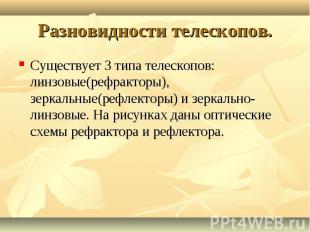
Description of the slide:
There are 3 types of telescopes: lens (refractors), mirror (reflectors) and mirror-lens. The figures show the optical schemes of the refractor and reflector. There are 3 types of telescopes: lens (refractors), mirror (reflectors) and mirror-lens. The figures show the optical schemes of the refractor and reflector.
slide number 7
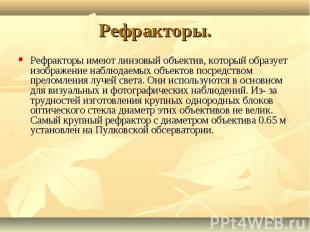
Description of the slide:
Refractors have a lens objective that forms an image of the observed objects by refraction of light rays. They are used mainly for visual and photographic observations. Due to the difficulties in manufacturing large homogeneous blocks of optical glass, the diameter of these objectives is not large. The largest refractor with a lens diameter of 0.65 m is installed at the Pulkovo Observatory. Refractors have a lens objective that forms an image of the observed objects by refraction of light rays. They are used mainly for visual and photographic observations. Due to the difficulties in manufacturing large homogeneous blocks of optical glass, the diameter of these objectives is not large. The largest refractor with a lens diameter of 0.65 m is installed at the Pulkovo Observatory.
slide number 8
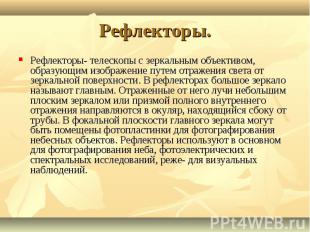
Description of the slide:
Reflectors-telescopes with a mirror lens that forms an image by reflecting light from a mirrored surface. In reflectors, the large mirror is called the main mirror. The rays reflected from it are small flat mirror or the prism of the total internal reflection are directed to the eyepiece located on the side of the pipe. Photographic plates can be placed in the focal plane of the main mirror to photograph celestial objects. Reflectors are used mainly for photographing the sky, photoelectric and spectral studies, less often for visual observations. Reflectors are telescopes with a mirror lens that forms an image by reflecting light from a mirrored surface. In reflectors, the large mirror is called the main mirror. The rays reflected from it are directed by a small flat mirror or a prism of total internal reflection into an eyepiece located on the side of the tube. Photographic plates can be placed in the focal plane of the main mirror to photograph celestial objects. Reflectors are used mainly for photographing the sky, photoelectric and spectral studies, less often for visual observations.
slide number 9
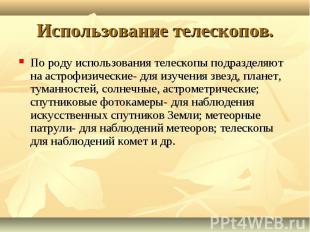
Description of the slide:
According to the type of use, telescopes are divided into astrophysical - for studying stars, planets, nebulae, solar, astrometric; satellite cameras - for observing artificial satellites of the Earth; meteor patrols - for observations of meteors; telescopes for observing comets, etc. According to the type of use, telescopes are divided into astrophysical - for studying stars, planets, nebulae, solar, astrometric; satellite cameras - for observing artificial satellites of the Earth; meteor patrols - for observations of meteors; telescopes for observing comets, etc.
slide number 10
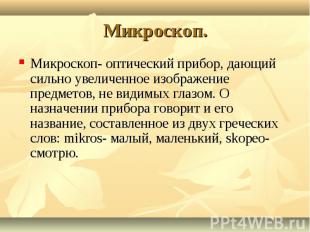
Description of the slide:
A microscope is an optical instrument that produces a highly magnified image of an object. visible to the eye. The purpose of the device is also indicated by its name, composed of two Greek words: mikros- small, small, skopeo- look. A microscope is an optical instrument that gives a greatly enlarged image of objects that are not visible to the eye. The purpose of the device is also indicated by its name, made up of two Greek words: mikros - small, small, skopeo - I look.
slide number 11
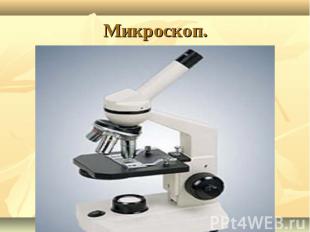
Description of the slide:
slide number 12
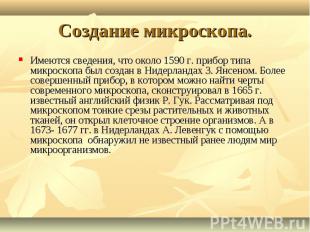
Description of the slide:
There is evidence that around 1590 a microscope-type device was created in the Netherlands by Z. Jansen. A more advanced device, in which the features of a modern microscope can be found, was designed in 1665 by the famous English physicist R. Hooke. Examining thin sections of plant and animal tissues under a microscope, he discovered cellular structure organisms. And in 1673-1677. in the Netherlands, A. Leeuwenhoek, using a microscope, discovered the world of microorganisms previously unknown to people. There is evidence that around 1590 a microscope-type device was created in the Netherlands by Z. Jansen. A more advanced device, in which the features of a modern microscope can be found, was designed in 1665 by the famous English physicist R. Hooke. Examining thin sections of plant and animal tissues under a microscope, he discovered the cellular structure of organisms. And in 1673-1677. in the Netherlands, A. Leeuwenhoek, using a microscope, discovered the world of microorganisms previously unknown to people.
slide number 13
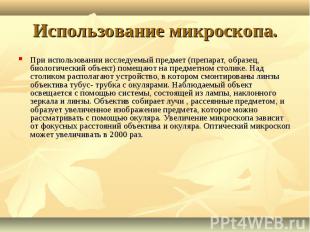
Description of the slide:
When using the object under study (preparation, sample, biological object) is placed on the object table. A device is placed above the table, in which the lenses of the objective tube-tube with eyepieces are mounted. The observed object is illuminated by a system consisting of a lamp, an inclined mirror and a lens. The lens collects the rays scattered by the object and forms an enlarged image of the object, which can be viewed with the help of an eyepiece. The magnification of a microscope depends on the focal lengths of the objective and the eyepiece. An optical microscope can magnify 2000 times. When using the object under study (preparation, sample, biological object) is placed on the object table. A device is placed above the table, in which the lenses of the objective tube-tube with eyepieces are mounted. The observed object is illuminated by a system consisting of a lamp, an inclined mirror and a lens. The lens collects the rays scattered by the object and forms an enlarged image of the object, which can be viewed with the help of an eyepiece. The magnification of a microscope depends on the focal lengths of the objective and the eyepiece. An optical microscope can magnify 2000 times.
slide number 14
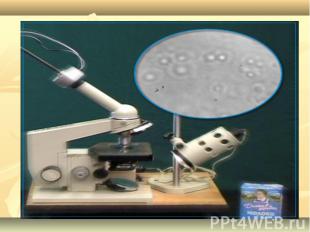
Description of the slide:
slide number 15
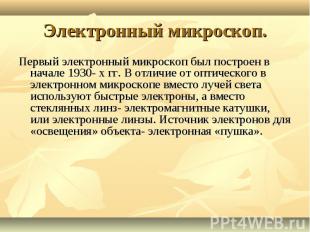
Description of the slide:
The first electron microscope was built in the early 1930s. In contrast to the optical one, in an electron microscope, instead of light rays, fast electrons are used, and instead of glass lenses, electromagnetic coils, or electronic lenses. The source of electrons for "illuminating" an object is an electron "gun". The first electron microscope was built in the early 1930s. In contrast to the optical one, in an electron microscope, instead of light rays, fast electrons are used, and instead of glass lenses, electromagnetic coils, or electronic lenses. The source of electrons for "illuminating" an object is an electron "gun".
Description of the slide:
The camera is a closed light-tight camera. The image of photographed objects is created on photographic film by a system of lenses, which is called a lens. A special shutter allows you to open the lens during exposure. The camera is a closed light-tight camera. The image of photographed objects is created on photographic film by a system of lenses, which is called a lens. A special shutter allows you to open the lens during exposure. A feature of the operation of the camera is that on a flat photographic film, sufficiently sharp images of objects located at different distances should be obtained.
slide number 19
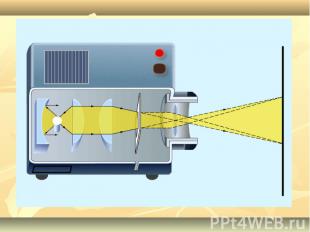
Description of the slide:
slide number 20
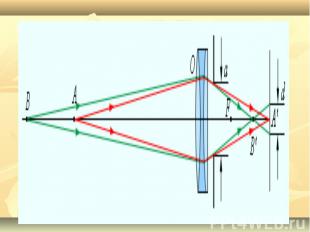
Description of the slide:
slide number 21
![]()
Description of the slide:
Photography was invented at the beginning of the last century. In 1840 the Moon was photographed for the first time, in 1842 the Sun. AT modern life, science and technology photography is very widely used. Cameras and shooting methods have been improved, color photography has been mastered. They take pictures of molecules and atoms, planets and stars, make surveys under the ode and from space. Until 1959, mankind did not know what kind of reverse side of the moon, not visible from the Earth, has. It was photographed for the first time with the help of the Soviet automatic interplanetary station, which launched on October 4, 1959. In September 1968, our planet Earth. Photographing was carried out using the automatic station "Zond-5". Photography was invented at the beginning of the last century. In 1840 the Moon was photographed for the first time, in 1842 the Sun. In modern life, science and technology, photography is very widely used. Cameras and shooting methods have been improved, color photography has been mastered. They take pictures of molecules and atoms, planets and stars, make surveys under the ode and from space. Until 1959, mankind did not know what kind of reverse side of the moon, not visible from the Earth, has. It was first photographed with the help of the Soviet automatic interplanetary station, launched on October 4, 1959. In September 1968, our planet Earth was photographed from space. Photographing was carried out using the automatic station "Zond-5".
slide number 22

Description of the slide:
The projection apparatus is intended for obtaining large-scale images. The projector lens O focuses the image flat object(diapositive D) on a distant screen E. A system of lenses K, called a condenser, is designed to concentrate the light of the source S on the slide. Screen E creates a truly enlarged inverted image. The magnification of the projector can be changed by zooming in or out of the screen E while changing the distance between the transparencies D and the lens O. The projector is designed to produce large-scale images. The lens O of the projector focuses the image of a flat object (slide D) on a distant screen E. The lens system K, called a condenser, is designed to concentrate the light of the source S on the slide. Screen E creates a truly enlarged inverted image. The magnification of the projection apparatus can be changed by zooming in or out of the screen E while changing the distance between the transparencies D and the lens O.
